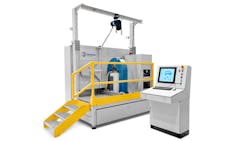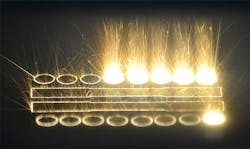Underlying all that is attempted and accomplished in forging and forming technology is material science, an increasingly wider field of R&D, design, and production methods. In the past decade, additive manufacturing has expanded the possibilities of metal forming and forging in multiple dimensions, creating new alloys, introducing new methods for shaping them, and applying more flexible design principles to established manufacturing systems.
For example, forming dies (for closed-die forging, stamping, diecasting, etc.) may require cooling channels so that the materials being formed can be quickly brought to a target temperature. In some applications, coolant channels have to be drilled into the die, making it difficult to control cooling across the die surface, especially on complex die shapes. Using additive manufacturing (3D printing,) Schuler AG recently produced prototype hot-stamping dies with “channels running in an improved near net shape,” thereby promoting more evenly distributed, fast cooling of all areas of the component – and thus improved part properties.
“The optimized cooling channel geometry makes the cooling of the die more homogenous and efficient,” according to Udo Binder, head of Schuler’s Intelligent Tooling Solutions division. “3D printing opens up new possibilities in the design of the cooling channels, so that they contribute to even cooling.”
Schuler’s additive manufacturing method is selective laser melting, converting a powder-metal material comparable to the tool steel alloy used to form stamping dies in the normal method. Depositing layers of the powder metal, using a laser to melt and bond each layer to the preceding one, Schuler demonstrated the possibility of forming a die segment that exhibits up to 95% of the mechanical-technical properties of the actual die.
Similarly, additive manufacturing may be used for die repair, drawing from the original die design data to program a deposition pattern, restoring fine details of the surface that have been damaged or lost in the course of normal forming operations.
Schuler’s die redesign effort was preceded by extensive research to determine the ideal process parameters and the optimal composition of the powdered material. After the new design was produced, tensile and specific density testing of the die segment were conducted, then followed by wear testing with an eye toward series production.
The role of additive manufacturing in established forming process routes is a more diffused subject, with various concepts being implemented now. Notable among these is the Ampliforge™ process developed by Alcoa and now being used by Arconic. The proprietary approach works with a 3D-printed part and follows with a more recognizable closed-die forging sequence, to produce parts that have density and mechanical strength thus far unachievable by standard additive manufacturing.
Design and Materials
According to Arconic Forgings and Extrusions vice president Ed Colvin, Ampliforge reduces the amount of material stock needed to form a part, cuts tooling costs and extends tooling life. In addition, it reduces processing time and “buy-to-fly” costs for aerospace parts. Most important, Ampliforge parts continue to meet design requirements for controlling strain and deformation.
To date, the aerospace market has provided most of the notable applications for additive manufactured parts. Last year Sintavia, an additive manufacturing enterprise, installed a Quintus Technologies QIH 15L press hot isostatic press with an 186×500-mm (7.3×19.7 in.) hot zone for processing metal pars for aerospace and defense programs.
“Without HIP technology, additively manufactured parts are susceptible to porosity and lack of fusion. HIP allows for near 100% net-density parts,” stated Sintavia founder Brian Neff, confirming a role for AM parts but also reaffirming the value of existing production technologies.
The Quintus press offers a proprietary process sequence, Uniform Rapid Cooling™ that incorporates densification and heat treatment capabilities, shortening cycle times. The press imparts pressures up to 30,000 psi (207 MPa), and handles temperatures up to 2,550°F (1,400°C), and has a modular design that shortens installation time and reduces space requirements.
“As the AM process continues to penetrate various supply chains, not just aerospace and defense, you’ll see more applications requiring HIP-ing,” Neff noted. “For certain very critical parts, HIP will become more or less the standard.”
Probably the most varied effects of additive manufacturing development are to be seen in the new alloys derived to form engineered parts. QuesTek Innovations LLC, an integrated computational materials engineering (ICME) outfit develops materials to meet specific goals for capital, processing, operating, or maintenance costs; or to improve environmental protection; or to enhance competition for manufacturers. Its Ferrium steel developments, for example, have gained particular notice as forged landing gears for U.S. Air Force and Navy jets.
Last month QuesTek announced six separate projects assigned by the U.S. Navy and U.S. Army to develop technologies and design new alloys specifically for additive manufacturing of particular parts, addressing the processing conditions and material-related challenges that AM makes necessary.
These new projects include further developing three QuesTek-designed aluminum alloys for Direct Metal Laser Sintering (DMLS); developing a new powder specification for high-strength martensitic precipitation-hardenable 17-4 stainless steel, optimized for selective laser melting (SLM); developing an “Integrated Model Toolkit” for modeling an AM process by predicting local composition, microstructure, residual stresses, defects, and mechanical properties for stainless steel 316L aerospace components; evaluating materials for DMLS production of naval heat exchangers; and extending the Accelerated Insertion of Materials (AIM) framework for managing the uncertainty of material properties to the mechanical performance of lasered AM Ti-6Al-4V materials. The goal of this last project is to develop a tool that can determine both property probability distributions and probability-distribution confidence intervals for AM parts, thus accelerating aerospace certification and flight qualification.
In another recent project, for the U.S. Army, QuesTek atomized, built via laser-engineered net shape (LENS) and DMLS AM processes, and evaluated its own carburizable Ferrium® C64® steel development. The goal was to develop and optimize an AM technique and post-build treatment process specifically for C64 steel, while meeting or exceeding the material performance of existing aerospace gear materials, such as AMS 6308 manufactured using traditional metallurgical routes.
The conclusion is that every established material or alloy, manufacturing method, or production process, offers possibilities for improvement. Additive manufacturing is opening up possibilities on all frontiers.
About the Author
Robert Brooks
Editor/Content Director - Endeavor Business Media
Robert Brooks has been a business-to-business reporter, writer, editor, and columnist for more than 20 years, specializing in the primary metal and basic manufacturing industries. His work has covered a wide range of topics including process technology, resource development, material selection, product design, workforce development, and industrial market strategies, among others.
Currently, he specializes in subjects related to metal component and product design, development, and manufacturing—including castings, forgings, machined parts, and fabrications.
Brooks is a graduate of Kenyon College (B.A. English, Political Science) and Emory University (M.A. English.)



